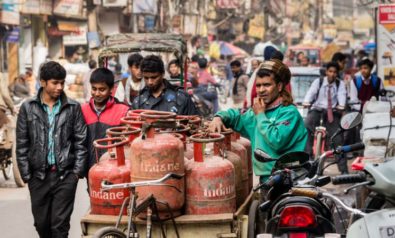To improve its air quality, India needs better implementation of its environmental laws.
In the course of two years, India has claimed from China the dubious distinction as the world’s most polluted country. Whether India deserves this title or not depends on how, when and where one chooses to measure pollution—questions that are often debated in the media. All this attention has increased awareness in India about the costs of air pollution, not least in New Delhi, where the country’s lawmakers breathe (what the BBC calls) the world’s most polluted air.
Even as it attempts to jumpstart the country’s economic performance, the Indian government has sought an energy and environmental policy agenda that is as ambitious as the pollution problem is dire. In 2014, Indian Prime Minister Narendra Modi set a goal to expand clean electricity-generating capacity: solar by a factor of 25 and wind by a factor of around three within eight years. This is enough clean energy to take the place of dozens of dirty-burning coal power plants. In spring 2015, Modi launched a color-coded Air Quality Index in major cities and promised to expand the network of air pollution monitors. His government is also planning new pollution standards for coal-fired power plants and considering a significant overhaul of India’s environmental laws.
Should these ambitious plans come to fruition, they hold real promise for improved environmental health in India. However, without a similarly ambitious effort to step up implementation across the environmental regulatory system, they are likely to join an unfortunately long list of solutions that looked good on paper but have yet to succeed in practice.
In contrast to what is often suggested in the press, the current pollution crisis is neither the first nor the worst the country has faced. The past four decades in India have seen a succession of environmental health warnings and crises, each followed by big plans to clean up.
Beginning in the 1970s, India adopted a series of landmark environmental protection and pollution control laws. These laws established standards for air and water quality, as well as monitoring and enforcement institutions that closely resembled those credited with dramatically reducing pollution in wealthy countries. India saw some modest gains in air quality under these laws, but the situation deteriorated as growth of polluting sectors of the economy—such as industry and power—outpaced enforcement capacity.
How big is India’s environmental policy implementation gap?
An author of this article, Rohini Pande, set out with several collaborators to measure how far India is from achieving the air quality standards prescribed by these laws. They also estimated how much longer Indians could expect to live if pollution were reduced to meet the standards by closing this implementation gap.
The results of the research are striking: 660 million Indians, about 55% of the population, live in areas where fine particle air pollution (called Particulate Matter 2.5) exceeds the national standard. Nearly half of these people live in areas where pollution levels are more than twice the standard.
Using the latest evidence from environmental health studies, the article estimates that these 660 million people would live on average 3.6 years longer if pollution were cut to the level prescribed by national standards. This cumulative gain of 2.1 billion life-years would be realized primarily through reduced risks of heart and lung illnesses associated with breathing fine particles, which can penetrate deep into the cardiovascular system.
Getting to better implementation
Why do India’s environmental laws fail to deliver the air quality improvements they promised? One important reason is that environmental regulators are forced to overcome persistent deficits of information and authority in order to enforce these laws. The challenges of enforcing pollution control standards for factories and power plants, which together are responsible for one of the largest shares of air pollution emissions in India, illustrate how these deficits result in an implementation gap.
Government agencies that enforce India’s Air and Water acts have only 200-300 technical staff to monitor at least 50,000 plants in some of the largest and most industrialized states. While plants are required to install pollution control equipment before beginning operation, regulators only have capacity to inspect most plants one or two times per year. As a result, many plants can get away with bypassing their pollution control equipment, which saves on electricity, chemicals and maintenance costs.
When these agencies manage to uncover violations, enforcement authorities have severe limitations that prevent them from punishing all but the most egregious violators. As violations of pollution standards are considered criminal offenses in India, regulators cannot issue fines or penalties. Instead, they are supposed to file criminal charges, which generally require spending months or years navigating India’s notoriously backlogged court system.
In practice, the only enforcement measure available to regulators is more drastic: shutting off a plant’s electricity or water connection until it shapes up. The resulting situation is as if the traffic police could only enforce traffic laws by throwing violators in jail. Unsurprisingly, this punishment is reserved for the most extreme violators, meaning that plants can routinely evade punishment while polluting at twice the legal limit or higher.
Convincing plants to turn on their pollution control equipment may be one of the quickest and cheapest ways to reduce pollution across India. Closing this implementation gap depends primarily on regulators having better information on plants’ pollution levels and proper authority to match punishments to the severity of violations.
We have advocated for allowing regulators to impose civil fines on violators; and some of our current research asks whether inexpensive electronic monitors that send real-time information on pollution from the plants’ smokestacks to regulators can be part of the solution to regulators’ information deficit.
These devices are called continuous emissions monitoring systems (CEMS) and represent a potential foundation for improved regulation of industrial pollution. Our organization, Evidence for Policy Design, based at the Harvard Kennedy School, has partnered with researchers from University of Chicago, Yale and MIT’s Abdul Latif Jameel Poverty Action Lab to work with the Indian government to pilot installation of CEMS devices. At the early stage of the pilot program, we helped design the software interface to process the pollution-monitoring data, which is beginning to receive information from CEMS devices in factories across target areas in Gujarat and Maharashtra. We hope to use the roll-out to understand how enhanced information transfers can improve pollution abatement in India.
Giving regulators access to better information and granting them the authority to impose fines on violators are important steps toward improving regulation and decreasing pollution. They represent solutions that consider not simply what the policy should say, but how it can be implemented. To make policies that work, we must focus on that vital but often neglected question.
The views expressed in this article are the author’s own and do not necessarily reflect Fair Observer’s editorial policy.
Photo Credit: Kotenko Oleksandr / Shutterstock.com
We bring you perspectives from around the world. Help us to inform and educate. Your donation is tax-deductible. Join over 400 people to become a donor or you could choose to be a sponsor.
Support Fair Observer
We rely on your support for our independence, diversity and quality.
For more than 10 years, Fair Observer has been free, fair and independent. No billionaire owns us, no advertisers control us. We are a reader-supported nonprofit. Unlike many other publications, we keep our content free for readers regardless of where they live or whether they can afford to pay. We have no paywalls and no ads.
In the post-truth era of fake news, echo chambers and filter bubbles, we publish a plurality of perspectives from around the world. Anyone can publish with us, but everyone goes through a rigorous editorial process. So, you get fact-checked, well-reasoned content instead of noise.
We publish 2,500+ voices from 90+ countries. We also conduct education and training programs
on subjects ranging from digital media and journalism to writing and critical thinking. This
doesn’t come cheap. Servers, editors, trainers and web developers cost
money.
Please consider supporting us on a regular basis as a recurring donor or a
sustaining member.
Will you support FO’s journalism?
We rely on your support for our independence, diversity and quality.

















Comment